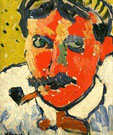Andre Deraine 1881-1954

"Painting is too beautiful to be reduced to images which may be compared with those of a dog or horse. It is imperative that we escape the circle in which the realists have trapped us."
Andre Derain was born in 1880 at Chatou, which was then a kind of artists'
colony at the gates of Paris. His father was a successful pastry chef
and town councillor. Derain's father was prosperous enough to want his
son to have the most respectable of careers, preferably engineering. But
Andre was already painting. When Henri Matisse, a fellow student saw some
of Andre's work and spoke glowingly to Derain's father, he finally relented.
In 1900, he met and shared a studio with Maurice de Vlaminck and began
to paint his first landscapes (Schatz).
Derain made his first impact on the Paris art scene in 1905, when he and
Matisse displayed their highly innovative paintings at the Salon d'Automne.
In March 1906, the noted art dealer Ambroise Vollard sent Derain to London
to compose a series of paintings with the city as subject. In 30 paintings
(29 of which still exist), Derain put forth a portrait of London that
was radically different from anything done by previous painters of the
city. With bold colors and compositions, Derain painted multiple pictures
of the Thames and Tower Bridge. To date, these London paintings remain
among his most popular work (Wikipedia).
In 1906 Derain met Picasso and soon afterward signed a contract with Daniel-Henri
Kahnweiler, Picasso's dealer. He married on the strength of his new financial
security and with his wife, Alice, went to live in Montmartre, where his
friendship with Picasso continued. During the 1930s he gradually lost
touch with many of his old friends. He lived in an 18th-century mansion
outside of Paris, and spent two or three hours a day drawing in the park
surrounding the house.
During the German occupation of France in World War II, Derain lived primarily
in Paris and was much courted by the Germans because he represented the
prestige of French culture. Derain accepted an invitation to make an official
visit to Germany in 1941. The Nazi propaganda machine naturally made much
of Derain's presence in Germany, and after the Liberation he was branded
a collaborator and ostracized by many people (Wikipedia).
By the time he was forty, he was one of the most successful painters in
Paris. But by the end of World War II, Derain's name usually came up only
to be dismissed with a shrug. Cynical, bitter and physically gross, he
withdrew to his country mansion to pursue his favorite hobbies: speeding
in his Bugatti sports car and gorging himself on food. His wife left him
and when he made headlines in 1954 after being hit by a car; many art
lovers thought he was already dead. Two months later he was - one of the
loneliest figures in the entire turbulent history of modern art (Shatz).
One of the original "wild beasts", he has been difficult to
appraise; but at its best, his work has also been almost impossible not
to like. The trauma of his years in the trenches had turned him toward
what is timeless. Today, paintings by Derain sell for as much as US$6
million. The London paintings were the subject of a major exhibition at
the Courtauld Institute in 2005-06 (Wikipedia).